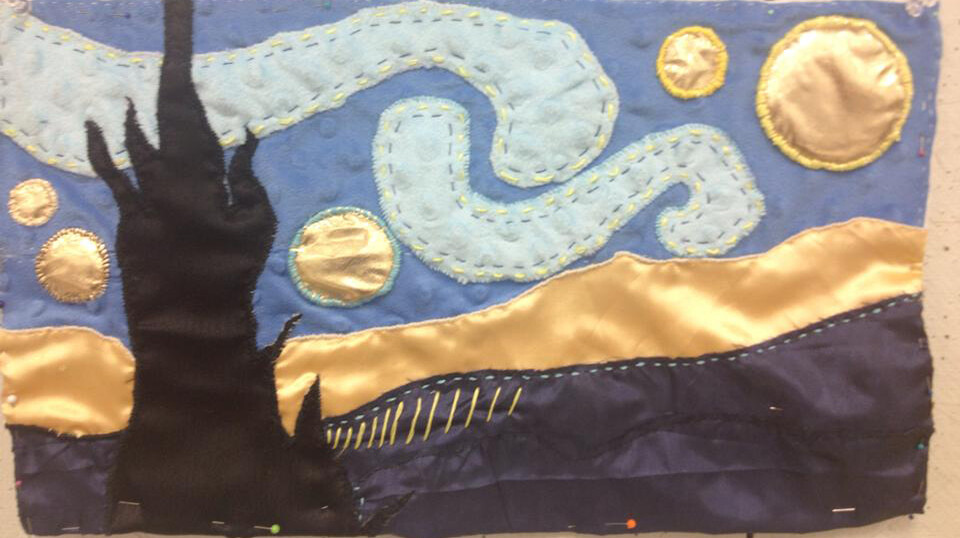
Students in associate professor of art Sandra Williams’ Color and Composition class this fall completed a project to recreate works of art in a tactual manner to be displayed at the Nebraska Center for the Education of Children Who Are Blind or Visually Impaired.
The project challenged students to think about their art in a whole new manner.
“There are very basic design concepts like texture and line, as well as really maybe thinking about some aesthetic qualities like, ‘What does green feel like?’ that apply to this project,” Williams said. “There is so much of our world that is visual. The visual is a very big part of learning and processing the world around you, so what happens when you don’t have that?”
So much of everyday visual vocabulary includes art.
“If you think about Mondrian’s ‘Broadway Boogie Woogie,’ everyone knows what that is. Everyone knows what ‘Persistence of Memory’ is or ‘Son of Man’ or ‘The Scream,’” Williams said. “All you have to do is name those paintings, and everyone automatically has an association. So what happens when you’re left out of that? What my students are doing is very simple. They’re recreating these pieces almost as art quilts.”
Students could choose from a list of pieces to recreate or choose their own.
“The inherent challenges in this involved considering what the most important image from history is to them and how best to communicate that image,” Williams said. “They were really learning about those works of art in a different way, and there was a lot of reflection about art, context and agency.”
Audrey Graves, the center’s program principal, contacted Williams about the idea.
“The idea for this project first came after visiting the South Dakota School for the Blind. Their school had partnered with a local university on creating tactual pieces of art that were displayed throughout their campus,” Graves said. “I immediately fell in love with this idea and wanted to pursue a similar project to be displayed at NCECBVI as well.”
Williams and Graves met with Mackenzie Savaiano, assistant professor of practice in special education and communication disorders in the College of Education and Human Sciences, to discuss access to art for people who are blind or visually impaired.
Graves and Savaiano also met with students in the class. The students used goggles and blindfolds that showed them what you see with various visual impairments.
Samantha Greenfield, a junior in the College of Arts and Sciences, learned to appreciate texture.
“This project has obviously made me a lot more sensitive to the texture of art,” said Greenfield, who recreated Johannes Vermeer’s “Girl with a Pearl Earring” for her project. “We spent so much time running our hands over what we made, which almost never happens in other projects. In the future, I will be more conscious of other senses besides sight that are involved in viewing art.”
The students also visited the International Quilt Study Center and Museum on East Campus, where docent Mary Olshavsky gave them a tour and discussed how to describe something to the visually impaired.
“It challenged our vocabulary in a different way,” Williams said. “How do you describe a texture like shingled? Or blue? The students had great questions like how do we access our other senses? If there was a bowl of flowers on a quilt, you could talk about the smell of freshly cut flowers.”
The project made students think differently about their artistic choices.
“If you’re doing a Roy Lichtenstein piece, and he uses the Ben-Day dots, do you need to reinterpret those?” Williams said. “Visually he uses color separation to distinguish from bright red lips to pink skin. What do you prioritize? Is it essential to find a texture that has little raised dots? Is something else more essential? We’re going to find out.”
Lexi Trumbley, a junior studio art major from Lincoln, recreated a piece by European street artist Bansky. The piece has no formal title, but is often referred to as “Raining Color” and is a stencil and spray paint piece on the side of a building.
“My piece was especially difficult because the original medium was spray paint on the side of a building,” Trumbley said. “I picked a street art piece because it is a form of art that people with a visual impairment would not be able to experience in their daily lives. My challenge was creating a piece that had many different and rich textures in order to separate each individual color, while still staying true to the flatness of the original piece. I also wanted to make sure that even though the original had a lot of visual information to take in, I needed to simplify the piece in order for someone without sight to have enough space to feel each different aspect of the recreated work without it being too confusing.”
The students’ pieces will be on display at the center on Feb. 11 during the Braille Challenge, a national reading and writing challenge for students who are blind or visually impaired.
“After the students have completed the competition and are waiting on their scores, the art project will be unveiled,” Graves said. “We plan to have the students learn about this project and have a chance to experience these works of art.”
The center celebrates its 140th anniversary March 18. The artwork will be showcased in this event as well and put on display at the school.
Graves said she hopes students continue to be influenced by this project in their future work.
“This way they can create a variety of artwork that can be enjoyed by all, regardless of abilities or disabilities,” she said.
For more information, click here.








